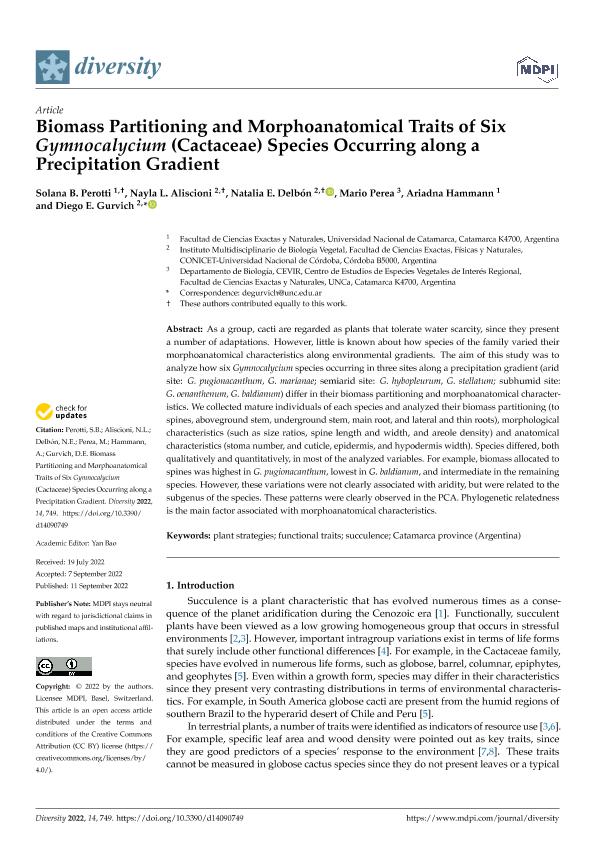Artículo
Biomass partitioning and morphoanatomical traits of six Gymnocalycium (Cactaceae) species occurring along a precipitation gradient
Perotti, Solana Belen ; Aliscioni, Nayla Luján
; Aliscioni, Nayla Luján ; Delbón, Natalia
; Delbón, Natalia ; Perea, Mario del Valle; Hammann, Ariadna; Gurvich, Diego Ezequiel
; Perea, Mario del Valle; Hammann, Ariadna; Gurvich, Diego Ezequiel
 ; Aliscioni, Nayla Luján
; Aliscioni, Nayla Luján ; Delbón, Natalia
; Delbón, Natalia ; Perea, Mario del Valle; Hammann, Ariadna; Gurvich, Diego Ezequiel
; Perea, Mario del Valle; Hammann, Ariadna; Gurvich, Diego Ezequiel
Fecha de publicación:
09/2022
Editorial:
MDPI
Revista:
Diversity
e-ISSN:
1424-2818
Idioma:
Inglés
Tipo de recurso:
Artículo publicado
Clasificación temática:
Resumen
As a group, cacti are regarded as plants that tolerate water scarcity, since they present a number of adaptations. However, little is known about how species of the family varied their morphoanatomical characteristics along environmental gradients. The aim of this study was to analyze how six Gymnocalycium species occurring in three sites along a precipitation gradient (arid site: G. pugionacanthum, G. marianae; semiarid site: G. hybopleurum, G. stellatum; subhumid site: G. oenanthenum, G. baldianum) differ in their biomass partitioning and morphoanatomical characteristics. We collected mature individuals of each species and analyzed their biomass partitioning (to spines, aboveground stem, underground stem, main root, and lateral and thin roots), morphological characteristics (such as size ratios, spine length and width, and areole density) and anatomical characteristics (stoma number, and cuticle, epidermis, and hypodermis width). Species differed, both qualitatively and quantitatively, in most of the analyzed variables. For example, biomass allocated to spines was highest in G. pugionacanthum, lowest in G. baldianum, and intermediate in the remaining species. However, these variations were not clearly associated with aridity, but were related to the subgenus of the species. These patterns were clearly observed in the PCA. Phylogenetic relatedness is the main factor associated with morphoanatomical characteristics.
Archivos asociados
Licencia
Identificadores
Colecciones
Articulos(IMBIV)
Articulos de INST.MULTIDISCIPL.DE BIOLOGIA VEGETAL (P)
Articulos de INST.MULTIDISCIPL.DE BIOLOGIA VEGETAL (P)
Citación
Perotti, Solana Belen; Aliscioni, Nayla Luján; Delbón, Natalia; Perea, Mario del Valle; Hammann, Ariadna; et al.; Biomass partitioning and morphoanatomical traits of six Gymnocalycium (Cactaceae) species occurring along a precipitation gradient; MDPI; Diversity; 14; 9; 9-2022; 1-14
Compartir
Altmétricas



